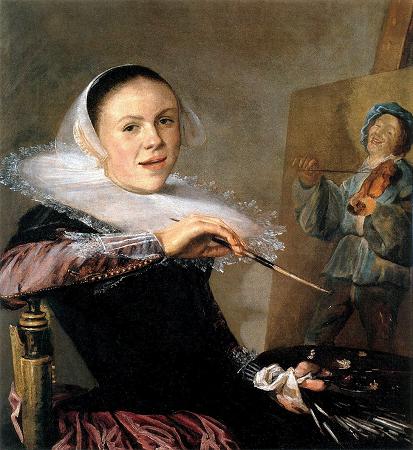
Judith Leyster Self Portrait. Self-portrait by Judith Leyster is an Dutch Golden Age painting in oils in the collection of the National Gallery of Art that was offered in 1633 as a masterpiece to the Haarlem Guild of St. Luke.
It was attributed for centuries to Frans Hals and was only properly attributed to Judith Leyster upon acquisition by the museum in 1949. The style is indeed comparable to that of Hals, Haarlem's most famous portraitist.
In 2016 a second self-portrait was found, dating from around 1653. Though Leyster looks very relaxed, the composition is to some extent an artificial confection.
She is dressed in what must have been her best clothes, which in reality she is unlikely to have risked near wet oil paint, and the figure she is painting is borrowed from a different work, and was perhaps never actually painted as a single figure. Critics have found a sense of Baroque closeness in this painting.
The artist and the viewer are very close in space. Many of the elements in the painting are foreshortened in order to feel closer and like they are coming into the viewer's space. For women during this time, being a painter was unusual. Judith Leyster, however, was a working artist at the age of eighteen. She became the first successful woman painter in the Netherlands during the height of Dutch art, known as the Dutch Golden Age. She taught students while running her own workshop and selling her work
It was attributed for centuries to Frans Hals and was only properly attributed to Judith Leyster upon acquisition by the museum in 1949. The style is indeed comparable to that of Hals, Haarlem's most famous portraitist.
In 2016 a second self-portrait was found, dating from around 1653. Though Leyster looks very relaxed, the composition is to some extent an artificial confection.
She is dressed in what must have been her best clothes, which in reality she is unlikely to have risked near wet oil paint, and the figure she is painting is borrowed from a different work, and was perhaps never actually painted as a single figure. Critics have found a sense of Baroque closeness in this painting.
The artist and the viewer are very close in space. Many of the elements in the painting are foreshortened in order to feel closer and like they are coming into the viewer's space. For women during this time, being a painter was unusual. Judith Leyster, however, was a working artist at the age of eighteen. She became the first successful woman painter in the Netherlands during the height of Dutch art, known as the Dutch Golden Age. She taught students while running her own workshop and selling her work
Wikipedia ...